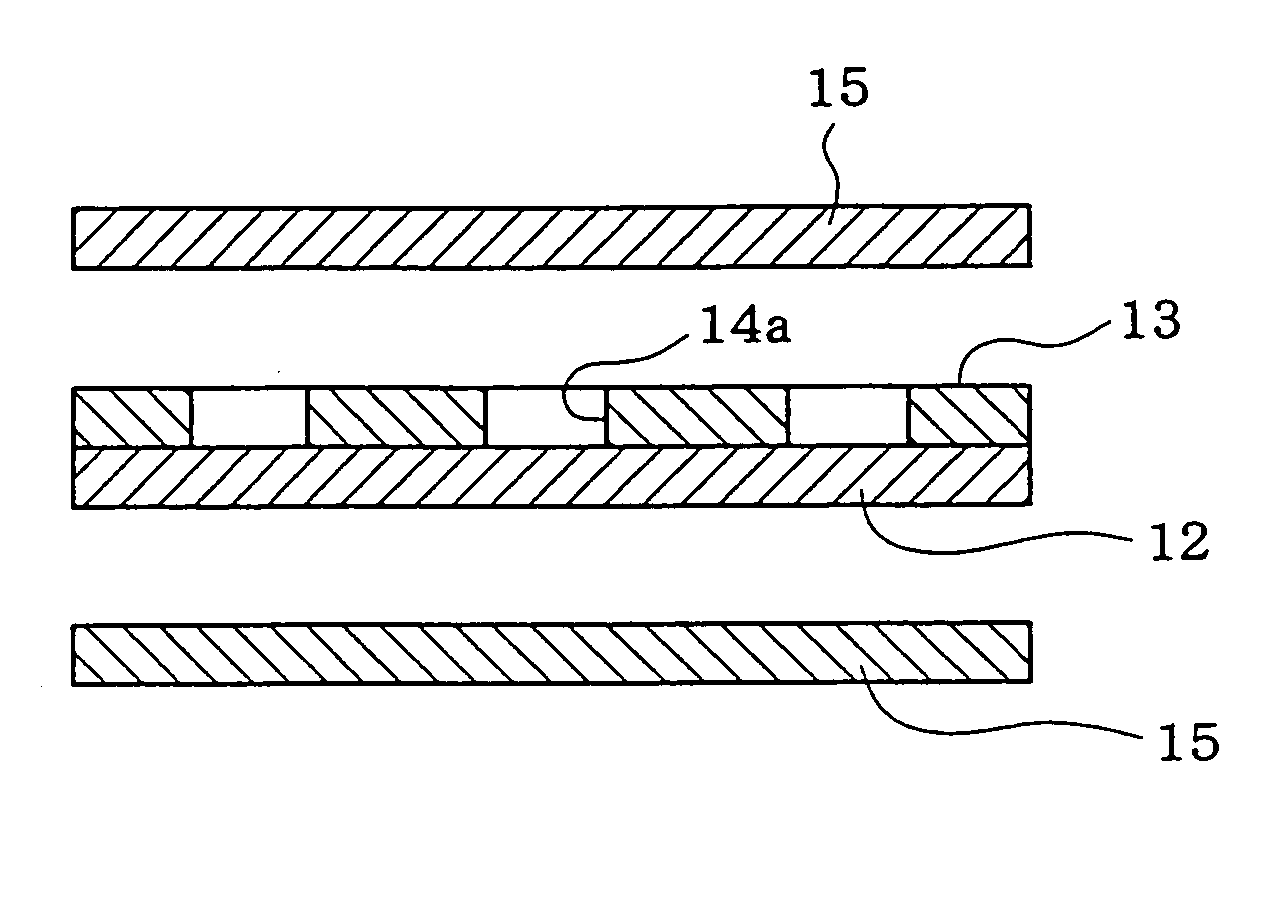Method of fabricating multilayer ceramic substrate
a multi-layer ceramic and substrate technology, applied in the field of multi-layer ceramic substrate fabrication, can solve the problems of delamination or warpage, and the difficulty of fabricating such a multi-layer ceramic substrate in the conventional manufacturing method, and achieve the effect of high dimensional accuracy
- Summary
- Abstract
- Description
- Claims
- Application Information
AI Technical Summary
Benefits of technology
Problems solved by technology
Method used
Image
Examples
first embodiment
[0036] A first embodiment in which the invention is applied to a method of fabricating a multilayer ceramic substrate having one side formed with a cavity will be described with reference to FIGS. 1A to 3. A multilayer ceramic substrate 11 having one side formed with a cavity is fabricated in the embodiment. In the substrate 11, one or a plurality of unfired low-temperature firable ceramic greensheets 13 are stacked and laminated on a previously fired substrate 12, so that a stack is formed, as shown in FIGS. 1C and 3. Two restricting greensheets 15 are further stacked on both sides of the laminate respectively. The stack is then fired at a temperature ranging from 800 to 1000° C. while being under restriction by the restricting greensheets 15 (with or without pressure applied). The previously fired substrate 12 forms a bottom of the cavity 14.
[0037] The multilayer ceramic substrate 11 is fabricated through the following steps. Firstly, the previously fired substrate 12 is prepared....
second embodiment
[0052] Even when the multilayer ceramic substrate 11 with cavities formed in both sides thereof is fabricated as in the second embodiment, the previously fired substrate 12 is positioned on the bottom of the cavity 14 and the stack is then fired under restriction. Consequently, the cavity bottom can be prevented from being warped into a convexity, the multilayer ceramic substrate 11 with both cavities having good dimensional accuracy can be fabricated.
[0053]FIGS. 5A to 5D illustrate a third embodiment of the invention. The cavity 14 is formed in the multilayer ceramic substrate 11 in each of the first and second embodiments. The cavity 14 has a stepless simple configuration in each embodiment. In this case, no problem of deformation of the cavity 14 arises even when a plurality of unfired low-temperature firable ceramic greensheets 13 are simultaneously stacked on the previously fired substrate 12 to be bonded together by the thermo-compression bonding as shown in FIG. 3.
third embodiment
[0054] On the other hand, a plurality of low-temperature firable ceramic greensheets 13 having respective cavity-forming openings 16a with different sizes are used when a stepped cavity 16 is formed in a multilayer ceramic substrate. In this case, when the low-temperature firable ceramic greensheets 13 are simultaneously stacked to be bonded together by the thermo-compression bonding as shown in FIG. 5D, there is a possibility that a resultant pressure may deform the stepped portions of the stepped cavity 16. The third embodiment is directed to a solution of the above-described problem. When a multilayer ceramic substrate 17 having the stepped cavity 16 is fabricated, an unfired low-temperature firable ceramic greensheet 13 the number of which corresponds to that of layers forming one step of the cavity 16 is stacked on the previously fired substrate 12 as shown in FIG. 5A. Subsequently, the restricting greensheet 15 is stacked on the unfired low-temperature firable ceramic greenshe...
PUM
| Property | Measurement | Unit |
|---|---|---|
| temperature | aaaaa | aaaaa |
| firing shrinkage | aaaaa | aaaaa |
| temperature | aaaaa | aaaaa |
Abstract
Description
Claims
Application Information
 Login to View More
Login to View More - R&D
- Intellectual Property
- Life Sciences
- Materials
- Tech Scout
- Unparalleled Data Quality
- Higher Quality Content
- 60% Fewer Hallucinations
Browse by: Latest US Patents, China's latest patents, Technical Efficacy Thesaurus, Application Domain, Technology Topic, Popular Technical Reports.
© 2025 PatSnap. All rights reserved.Legal|Privacy policy|Modern Slavery Act Transparency Statement|Sitemap|About US| Contact US: help@patsnap.com



